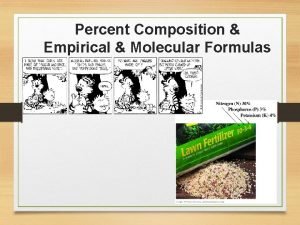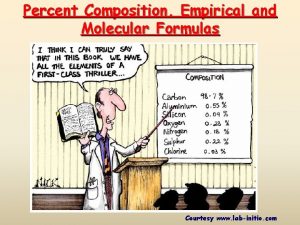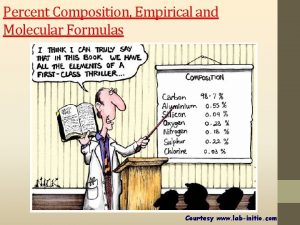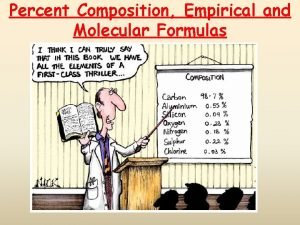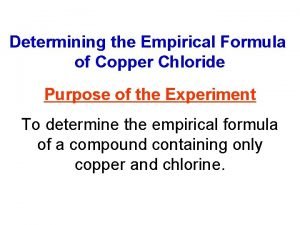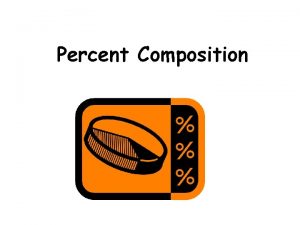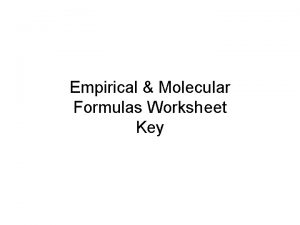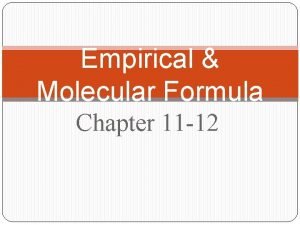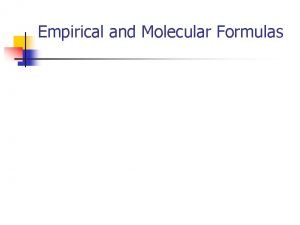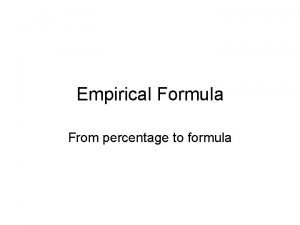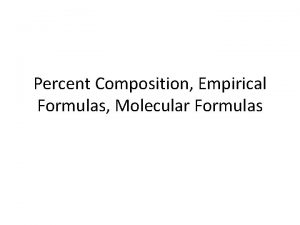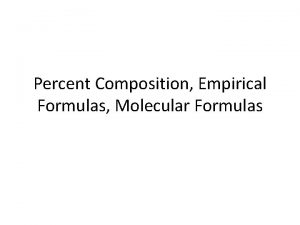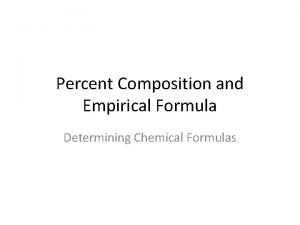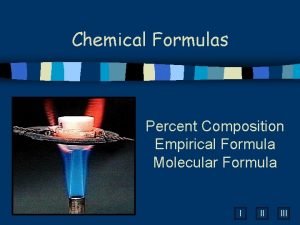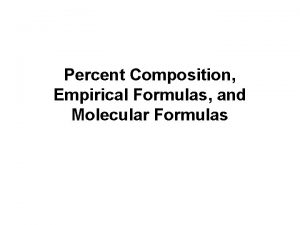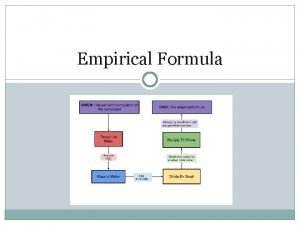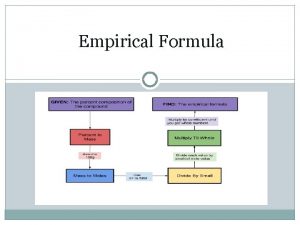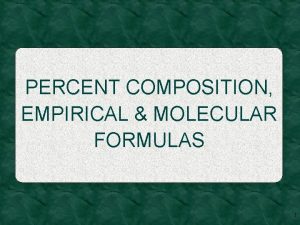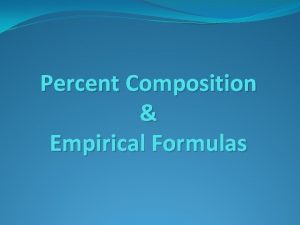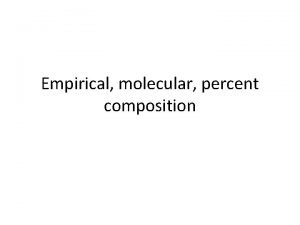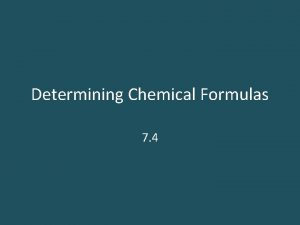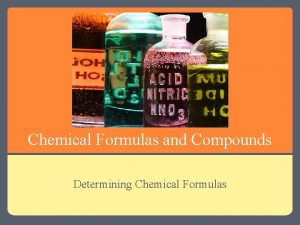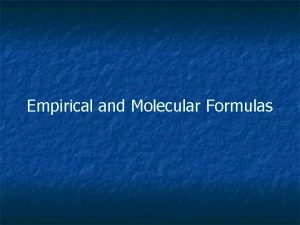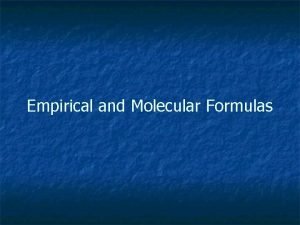Percent Composition and Empirical Formula Determining Chemical Formulas




















- Slides: 20

Percent Composition and Empirical Formula Determining Chemical Formulas

Percent Composition What does composition mean? • It is the physical make up of a substance • The difference substances that make up a substance. The individual parts.

How to find Percent Composition • Percent composition is the percent by mass of each element present in a compound. • Water, H 2 O, is the first example. • One mole of water is 18. 0152 grams. • In that compound, there are two moles of H atoms and 2 x 1. 008 = 2. 016 grams. That's how many grams of hydrogen are present in one mole of water. • There is also one mole of oxygen atoms weighing 16. 00 grams in the mole of water.

• To get the percentage of hydrogen, divide the 2. 016 by 18. 015 and multiply by 100, giving 11. 19%. • For oxygen it is 16. 00 ÷ 18. 015 = 88. 81%. • Notice that you can also minus hydrogen's percentage from 100%. You can always do this with the last part of this type problem.

Example Problem • Glucose, C 6 H 12 O 6, is the second example. • 1. figure out the molar mass from the formula. 2. figure out the grams each atom contributes by multiplying the atomic weight by the subscript. 3. divide the answer for each atom by the molar mass and multiply by 100 to get a percentage. **Remember, you may figure out the last percentage by subtracting the total percent from 100, as will be done in a moment. • Step One: mass of one mole = 180. 16 g

• Step Two: • Carbon = 6 x 12. 011 g = 72. 066 g Hydrogen = 12 x 1. 008 = 12. 096 g The oxygen percentage will be arrived at by subtraction. • Step Three: • Carbon's percentage: (72. 066 g / 180. 16 g) x 100 = 40. 00 % • Hydrogen's percentage: (12. 096 g / 180. 16 g) x 100 = 6. 71 % • Oxygen's percentage: 100 - (40. 00 + 6. 71) = 53. 29 %You may calculate the oxygen percentage if you wish.

Chemical Formula for humans

Empirical Formula • "Empirical formula" is a REAL IMPORTANT concept. • Here's the definition: the formula of a compound expressed as the smallest possible whole-number ratio of subscripts of the elements in the formula

• For example, CH 3 COOH has two carbons, four hydrogens and two oxygens. So we could write the formula like this: C 2 H 4 O 2 and so it reduces to CH 2 O. • Contrast the above definition to this one for "molecular formula: " the formula of a compound in which the subscripts give the actual number of each element in the formula

Formula Examples Notice two things: 1. The molecular formula and the empirical formula can be identical. 2. You scale up from the empirical formula to the molecular formula by a whole number factor. Molecular Formula Empirical Formula H 2 O CH 3 COOH CH 2 O C 6 H 12 O 6 CH 2 O

The Steps • A Simple Rhyme for a Simple Formula by Joel S. Thompson Journal of Chemical Education Vol. 65, No. 8; August 1988, p. 704 • When teaching the method for converting percentage composition to an empirical formula, I have devised the following rhyme: Percent to mass Mass to mole Divide by small Multiply 'til whole

Here's an example of how it works • A compound consists of 72. 2% magnesium and 27. 8% nitrogen by mass. What is the empirical formula? (1) Percent to mass: • Assume 100 g of the substance, then 72. 2 g magnesium and 27. 8 g nitrogen. (2) Mass to moles: • for Mg: 72. 2 g Mg x (1 mol Mg/24. 3 g Mg) = 2. 97 mol Mg for N: 27. 8 g N x (1 mol N/14. 0 g N) = 1. 99 mol N (3) Divide by small: • for Mg: 2. 97 mol / l. 99 mol = 1. 49 for N: 1. 99 mol / l. 99 mol = 1. 00 (4) Multiply 'til whole: • for Mg: 2 x 1. 49 = 2. 98 (i. e. , 3) for N: 2 x 1. 00 = 2. 00 • and the formula of the compound is Mg 3 N 2.

More Info • (1) Percent to mass: the assumption of 100 grams is purely for convenience sake. This means that the percentages transfer directly into grams. If you assumed that 36. 7 grams were present, you would have to multiply 36. 7 by each percentage. Assuming 100 grams makes it much easier. • (2) Mass to moles: this is a technique you should ALREADY know.

• (3) Divide by small: make sure you divide ALL answers from #2 by the smallest value. This may seem obvious, but there are students who neglect to divide the smallest value by itself to get one. • (4) Multiply 'til whole: multiply ALL values from #3 by the same factor. This factor is selected so as to produce ALL whole numbers as answers. Often this factor is chosen by trialand-error.

Example Problem! • A compound is analyzed and found to contain 68. 54% carbon, 8. 63% hydrogen, and 22. 83% oxygen. The molecular weight of this compound is known to be approximately 140 g/mol. What is the empirical formula? What is the molecular formula? • 1) Percent to mass. Assume 100 grams of the substance is present, therefore its composition is: • carbon: 68. 54 grams hydrogen: 8. 63 grams oxygen: 22. 83 grams

• (2) Mass to moles. Divide each mass by the proper atomic weight. • carbon: 68. 54 / 12. 011 = 5. 71 mol hydrogen: 8. 63 / 1. 008 = 8. 56 mol oxygen: 22. 83 / 16. 00 = 1. 43 mol • (3) Divide by small: • carbon: 5. 71 ÷ 1. 43 = 3. 99 hydrogen: 8. 56 ÷ 1. 43 = 5. 99 oxygen: 1. 43 ÷ 1. 43 = 1. 00

• (4) Multiply 'til whole. Not needed since all values came out whole. • The empirical formula of the compound is C 4 H 6 O

Now the Molecular Formula • Next we need to determine the molecular formula, knowing the empirical formula and the molecular weight. • Here's how: • 1) Calculate the "empirical formula weight. " This is not a standard chemical term, but the Chem. Team believes it is understandable. • C 4 H 6 O gives an "EFW" of 70. 092.

And finally 2) Divide the molecular weight by the "EFW. " • 140 ÷ 70 = 2 3) Multiply the subscripts of the empirical formula by the factor just computed. C 4 H 6 O times 2 gives a formula of C 8 H 12 O 2. This is the molecular formula.

• Credit the Chem. Team website for material borrowed and used for this class.
 How to find empirical formula from percentages
How to find empirical formula from percentages Empirical formula for adrenaline
Empirical formula for adrenaline Molecular formula equation
Molecular formula equation Percentage of composition
Percentage of composition Empirical formula to percent composition
Empirical formula to percent composition How to get empirical formula from percentages
How to get empirical formula from percentages How to find molecular formula
How to find molecular formula How to find the empirical formula from percent composition
How to find the empirical formula from percent composition Empirical formula of copper chloride
Empirical formula of copper chloride Chapter 7 review chemical formulas and chemical compounds
Chapter 7 review chemical formulas and chemical compounds Modern chemistry chapter 7 review answers
Modern chemistry chapter 7 review answers What is the percentage composition of oxygen
What is the percentage composition of oxygen Valid percent
Valid percent Empirical and molecular formula worksheet
Empirical and molecular formula worksheet Molar mass of ibuprofen
Molar mass of ibuprofen Molecular formula
Molecular formula How to find empirical formula
How to find empirical formula How to find empirical formula
How to find empirical formula Empirical formula of pentane
Empirical formula of pentane Molecular formula
Molecular formula How to determine empirical formula
How to determine empirical formula

